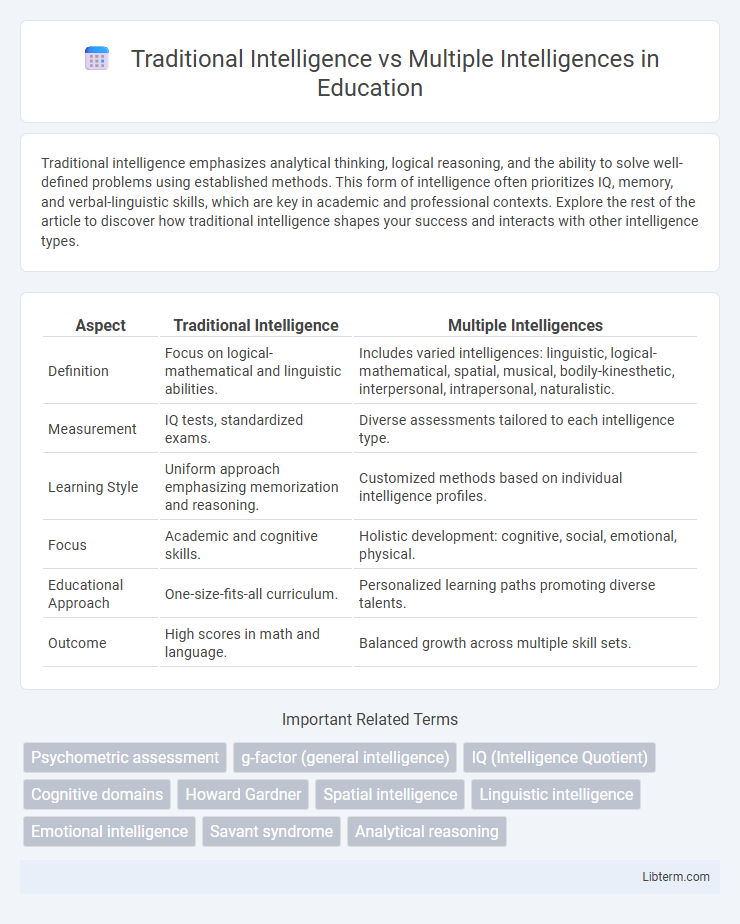Traditional intelligence emphasizes analytical thinking, logical reasoning, and the ability to solve well-defined problems using established methods. This form of intelligence often prioritizes IQ, memory, and verbal-linguistic skills, which are key in academic and professional contexts. Explore the rest of the article to discover how traditional intelligence shapes your success and interacts with other intelligence types.
Table of Comparison
| Aspect | Traditional Intelligence | Multiple Intelligences |
|---|---|---|
| Definition | Focus on logical-mathematical and linguistic abilities. | Includes varied intelligences: linguistic, logical-mathematical, spatial, musical, bodily-kinesthetic, interpersonal, intrapersonal, naturalistic. |
| Measurement | IQ tests, standardized exams. | Diverse assessments tailored to each intelligence type. |
| Learning Style | Uniform approach emphasizing memorization and reasoning. | Customized methods based on individual intelligence profiles. |
| Focus | Academic and cognitive skills. | Holistic development: cognitive, social, emotional, physical. |
| Educational Approach | One-size-fits-all curriculum. | Personalized learning paths promoting diverse talents. |
| Outcome | High scores in math and language. | Balanced growth across multiple skill sets. |
Understanding Traditional Intelligence
Traditional intelligence primarily emphasizes logical reasoning, linguistic ability, and mathematical skills, often measured through IQ tests. This conventional view focuses on analytical thinking and problem-solving within structured academic contexts. Understanding traditional intelligence involves recognizing its role in assessing cognitive abilities tied to standardized educational performance.
Origins of Multiple Intelligences Theory
The theory of Multiple Intelligences was developed by Howard Gardner in 1983 as a response to the limitations of Traditional Intelligence, which primarily measured intellectual capabilities through IQ tests. Gardner identified eight distinct types of intelligences, including linguistic, logical-mathematical, musical, bodily-kinesthetic, spatial, interpersonal, intrapersonal, and naturalistic intelligences. This theory expanded the understanding of human capabilities beyond conventional cognitive skills, emphasizing diverse ways individuals process information and solve problems.
Key Differences Between IQ and MI Models
Traditional Intelligence, measured by IQ tests, emphasizes logical reasoning, linguistic ability, and mathematical skills as primary indicators of cognitive capacity. In contrast, Multiple Intelligences (MI) theory, developed by Howard Gardner, expands intelligence to include diverse domains such as musical, bodily-kinesthetic, interpersonal, and intrapersonal intelligence. The IQ model quantifies intelligence on a singular scale, while MI recognizes varied intelligences as distinct yet equally valuable dimensions of human potential.
Core Types of Multiple Intelligences
Traditional intelligence typically measures cognitive abilities such as logical reasoning and linguistic skills through IQ tests, emphasizing analytical thinking. Multiple Intelligences theory, developed by Howard Gardner, identifies core types including linguistic, logical-mathematical, spatial, musical, bodily-kinesthetic, interpersonal, intrapersonal, and naturalistic intelligences, highlighting diverse cognitive strengths. These varied intelligences broaden understanding of human potential beyond conventional metrics, encompassing creativity, social skills, and physical coordination.
Strengths of Traditional Intelligence Assessment
Traditional intelligence assessments offer standardized measurement of cognitive abilities such as logical reasoning, verbal comprehension, and mathematical skills, which are crucial for academic and professional success. These assessments provide reliable, quantifiable data that help identify intellectual strengths and weaknesses across diverse populations. Their established validity and widespread use facilitate consistent comparisons and targeted interventions in educational and psychological settings.
Criticisms of Traditional Intelligence Testing
Traditional intelligence testing primarily measures analytical and logical reasoning skills, often neglecting diverse cognitive abilities such as creativity, emotional awareness, and practical problem-solving. Critics argue these tests exhibit cultural bias, limiting their accuracy and fairness across different populations and socioeconomic backgrounds. The theory of Multiple Intelligences highlights this limitation by proposing a broader spectrum of intelligences, including linguistic, musical, interpersonal, and kinesthetic, which traditional tests typically overlook.
Applications of Multiple Intelligences in Education
Multiple Intelligences theory transforms education by tailoring teaching strategies to diverse cognitive strengths like linguistic, logical-mathematical, spatial, musical, bodily-kinesthetic, interpersonal, intrapersonal, and naturalistic intelligences. This approach promotes personalized learning experiences, boosting student engagement and academic performance by recognizing unique talents and learning styles. Educators implement varied instructional methods such as project-based learning, collaborative activities, and experiential tasks to address multiple intelligences, fostering inclusive and effective educational environments.
Cross-Cultural Perspectives on Intelligence
Traditional intelligence, often measured by IQ tests, emphasizes logical reasoning and linguistic abilities, which may not fully capture the diverse cognitive strengths valued across cultures. Multiple intelligences theory, introduced by Howard Gardner, recognizes varied forms such as interpersonal, musical, and bodily-kinesthetic intelligence, reflecting cultural differences in defining intelligence. Cross-cultural perspectives highlight that intelligence is context-dependent, challenging standardized assessments to accommodate diverse cultural practices and cognitive skills.
Implications for Personal and Professional Growth
Traditional intelligence, often measured by IQ tests, emphasizes logical reasoning, mathematical ability, and linguistic skills, which are crucial for academic success and analytical problem-solving in professional settings. Multiple intelligences theory, proposed by Howard Gardner, expands this view by recognizing diverse cognitive strengths such as interpersonal, intrapersonal, musical, spatial, and bodily-kinesthetic intelligences, offering a broader framework for personal development. Embracing multiple intelligences enables individuals to leverage their unique talents, fostering creativity, emotional intelligence, and adaptability that drive professional growth and fulfill holistic personal potential.
The Future of Intelligence Measurement
Traditional intelligence measurement relies heavily on IQ tests that evaluate logical reasoning, mathematical ability, and linguistic skills, often neglecting diverse cognitive strengths. Multiple Intelligences theory, introduced by Howard Gardner, expands this framework to include interpersonal, intrapersonal, spatial, musical, and kinesthetic intelligences, offering a more holistic approach. The future of intelligence measurement is moving towards personalized, adaptive assessments integrating AI and neurotechnology to capture this broader spectrum of human capabilities accurately.
Traditional Intelligence Infographic

 libterm.com
libterm.com